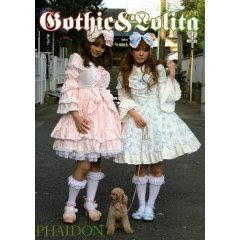The basics of this story are not new: general cultural commodification combined with racialized doll-silence. As MiHi Ahn puts it in Salon: “Gwen Stefani neuters Japanese street fashion to create spring’s must-have accessory: Giggling geisha!”. I though others had covered it all, until I recently saw a click-through ad for a partnership between Stefani and HP to create my own customized Harajuku girl. The product website exclaims
Turn you and your friends into Gwen and her Harajuku Girls. Customize their eye and hair color, even their stage wardrobe, before printing out the dolls and bringing them to life. You can even print out your own paper dolls to decorate your room or greeting cards featuring your Harajuku creation. (emphasis added — and it is interesting to note thatthe skin color can be changed, but not the features)
What? There are already living Harajuku girls and boys (as in from Harajuku & in the style)! This subculture is based on a high degree of gothy weirdness combined with the Japanese penchant for cuteness (called kawaii). Now you can now pretend to be someone (via a paper doll) who is a stand-in for someone (Gwen or her version of Harajuku girls) who is pretending to be/an homage to/stealing the cultural capital (choose one!) of actual people! Fun!
Gwen has appropriated the Harajuku look — re-naming her backup dancers as a group as the Harajuku Girls & she has a fashion label called Harajuku Lovers (and a tour named after the label). There are live trademarks in the United States for Harajuku Lovers & Harajuku Lovers A Fatal Attraction to Cuteness. Yet I’m sure that when Stefani used a sample of “The Lonely Goatherd” from the musical The Sound of Music by Rodgers and Hammerstein for her song “Wind it Up,” contracts were signed and money was exchanged. And Gwen will defend her trademarks based on Harajuku-style — as shown in a recent Forever 21 lawsuit.
But those trademarks — and the rest of her “cutting-edge” image are built on the cultural production of others — the actual Harajuku girls — and boys — who use their amazing skills to create bizarre/cute outfits.
Gwen Stefani wants you to know that she just oozes creativity from every pore. “People think you can turn creativity on and off, but it’s not like that,” the singer-cum-designer declares while sashaying through a cloud of fluttering photographs. “It just kind of comes out, a mashup of all these things you collect in your mind.”
Shoichi Aoki, Fresh Fruits, ISBN: 978-0714845104
Izumi Evers & Patrick Macias & Kazumi Nonaka, Japanese Schoolgirl Inferno: Tokyo Teen Fashion Subculture Handbook, ISBN: 978-0811856904



[…] Geishas does discuss Japanese female fashion, including Harajuku, Lolita, and Gothic Lolita. (Interestingly, though Chambers is an African-American woman, she never […]
I agree 100%. Gwen Stefani is not only exploiting the Gothic/Lolita scene, she also doesn’t know ANYTHING about it… She walked by, snapped a few pictures, and decided she was an expert. Those kids go to that bridge, dress up one night a week to hang out with friends and feel like they can be original for a while before returning to reality. It’s much more than a fashion statement, and she’s really just destroying the whole thing…
[…] The New York Times recently had an article on the difficulty of Japanese fashion designers to find recognition outside of Japan. Surprisingly, there was only passing reference to the appropriation of Japanese fashion — completely sans mention of the problematic aspects of Gwen Stefani and her fashion line, Harujuku Girls. […]